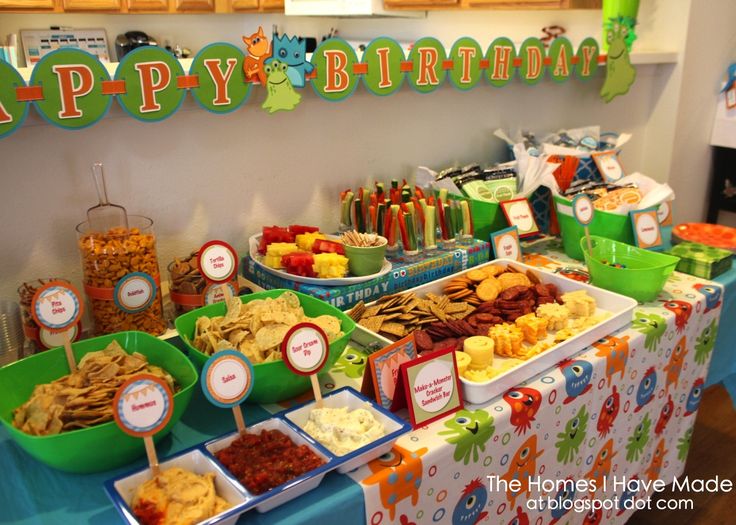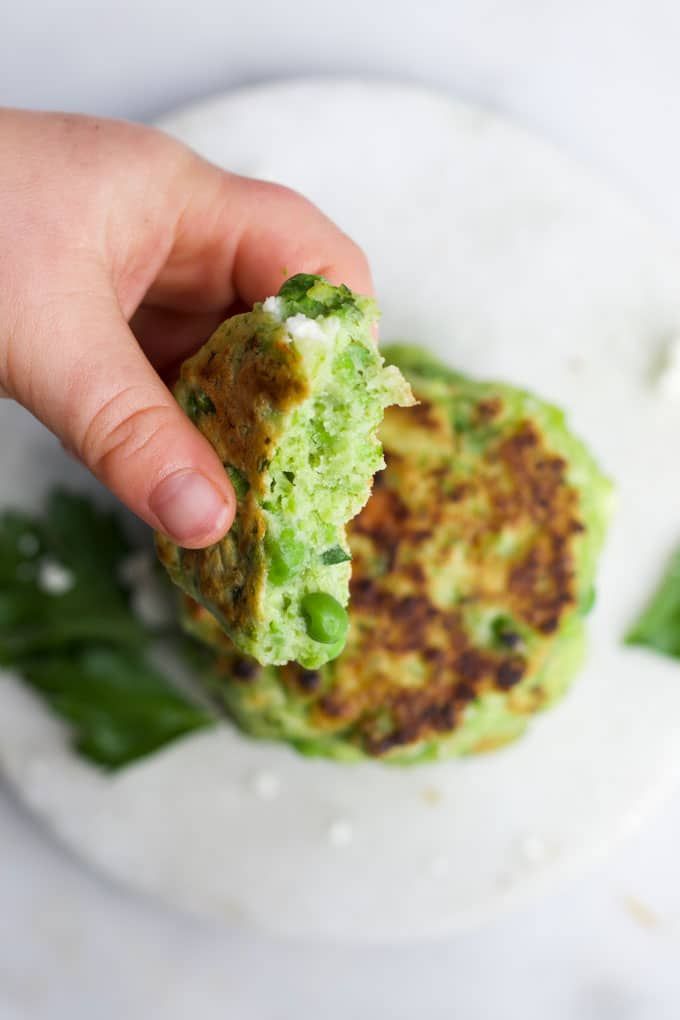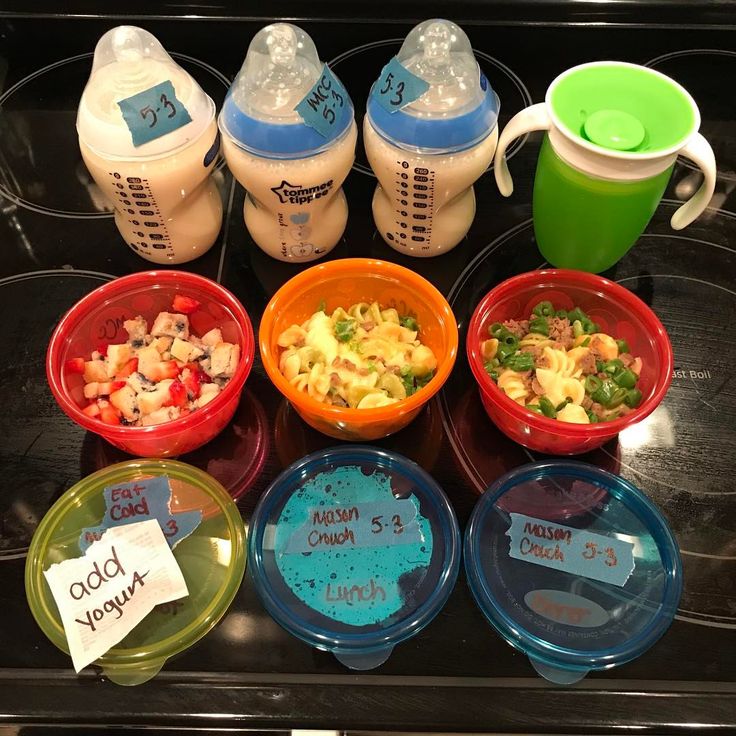Four months old baby food
Top 10 Ideas For 4 Month Baby Food
Some fruits and boiled vegetables may be given to your baby to fulfill their needs.
Image : Shutterstock
Finding suitable food ideas for your four months old baby may be confusing as this is probably the first time they are being introduced to solid food.
As babies turn four months, they become more active and playful. In addition, they start to exhibit more interest in their surroundings. Their stomachs also grow bigger and are ready for more food. Moreover, they seem less interested in milk and are ready to explore new food varieties.
If you recognize these signs in your baby, it is an indication that they have reached the developmental milestone where you may introduce them to solid foods.
Read the post to find whether your baby is ready for solids and to discover some interesting food ideas for them.
Is Your Baby Ready For Solids?
Your baby must have lost the ‘tongue thrust reflex’ by the time he is four months of age. Thrust reflex prevents the infants from choking. It also causes them to push the food out of their mouths. The World Health Organization recommends that we start solids at six months but solids may be introduced at four months. If your baby seems unsatisfied after milk feeds, can hold their head up without any support, can sit without support, wakes up more frequently at night to feed, follows your food with their eyes when you eat, then probably it is the time to introduce him to solid foods. See if your baby is interested in the food or not. If your child stares and grabs your food at dinnertime, then he is ready for some variety. The baby should be able to sit well without any support. Your child needs a good neck control to eat solid foods. It will enable him to swallow his food efficiently. The 4 months baby food should consist of solids.
Related: How To Teach A Baby To Chew And Swallow Their Food?
Top 10 Ideas
Here are the top 10 ideas for 4 month baby food old as he begins his journey into solid foods.
1. Baby Cereal:
Baby cereal is the most recommended first food for infants. Prepare the cereal with formula or breast milk. It will give the cereal a texture and taste that he is already familiar with. Cereal is also one of the least allergenic foods, making it suitable for babies of 4 months. Give gluten-free cereal, particularly if you have a family history of Celiac diseases or allergies. Wheat, barley and rye cereal may be unsuitable for babies as they contain gluten. Rice and oatmeal are the least allergenic varieties of cereal.
2. Avocado:
Image: Shutterstock
If you want to serve a complete and delicious meal for your baby, then you can serve him avocado. Slice an avocado and spoon out the flesh. Mash it with a fork or puree in a food processor. Add breast milk or formula milk to make it more ‘soupy’.
Related: 11 Tasty And Easy-To-Make Avocado Baby Food Recipes
3. Banana:
Bananas are considered one of the nature’s most perfect foods.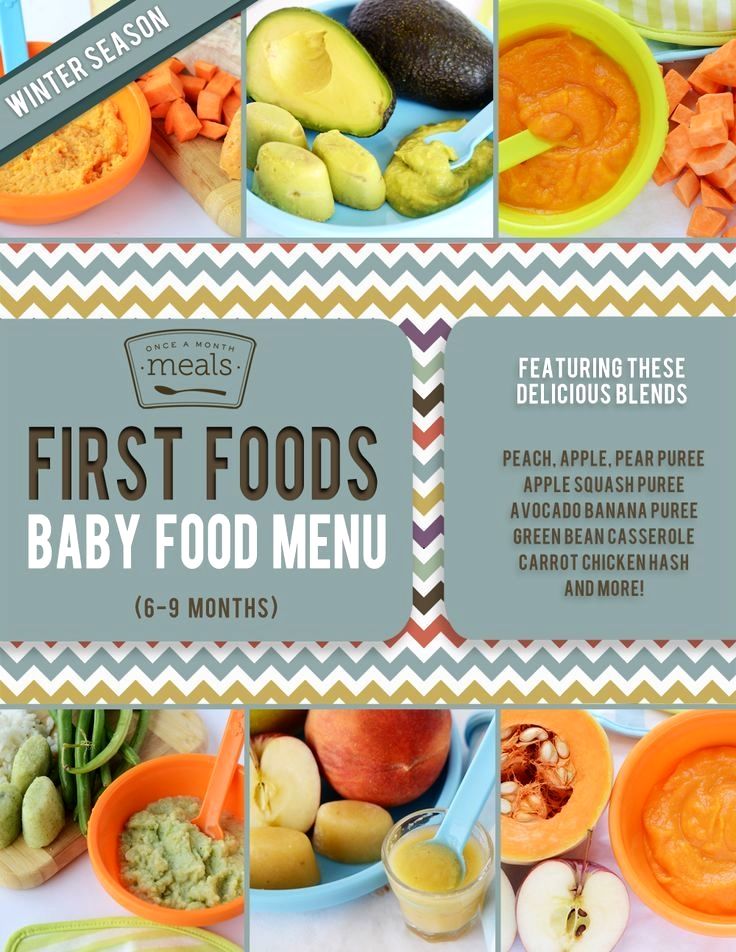 Babies love them for their natural sweetness. Also, banana is rich in fiber, so it will keep the things moving through your tot’s digestive system. Remove the skin of the banana and puree the flesh. You can also thin it with a little formula milk or breast milk. The food for 4 months baby is tasty with this all round nutritious fruit.
Babies love them for their natural sweetness. Also, banana is rich in fiber, so it will keep the things moving through your tot’s digestive system. Remove the skin of the banana and puree the flesh. You can also thin it with a little formula milk or breast milk. The food for 4 months baby is tasty with this all round nutritious fruit.
4. Butternut Squash:
Image: Shutterstock
Butternut squash has a pleasing texture, making it ideal for a baby’s palate. Baked butternut squash will make a great food for your little one. All you need to do is pierce the butternut squash and bake for an hour at 375 degrees. Cut it lengthwise and then scoop out the fibers and seeds. Then spoon out the flesh and mash with a fork or masher.
Related: 9 Tasty Butternut Squash Baby Food Recipes
5. Sweet Potato:
Sweet potato is a popular first food for babies. It is easier to digest and does not cause constipation in children. Cut the sweet potato and simmer in a little water until tender. Transfer to a food processor and puree, adding a little water or breast milk.
Transfer to a food processor and puree, adding a little water or breast milk.
Related: Carrot For Babies: 11 Nutritious And Easy-To-Make Recipes
6. Carrots:
Image: Shutterstock
Carrot is another great choice for baby food. Cut the carrots into sticks and bake for over 20 to 30 minutes at 375 degrees Fahrenheit. The food for 4 month old baby is healthy with carrots.
7. Apple:
With your doctor’s consent, you can serve cooked apples to your baby. Dice the apple and simmer or steam until tender. Cooking apple until it is just tender will ensure that all the nutrients are preserved. Transfer to a blender or food processor and blend until smooth. The 4 month old baby food is extremely nutritious with this addition.
Related: Cow Milk For Babies: Right Age, Benefits And Side Effects
8. Pear:
Image: Shutterstock
Pears are one of the safest foods to give as a first food. The allergic reactions to pear are rare.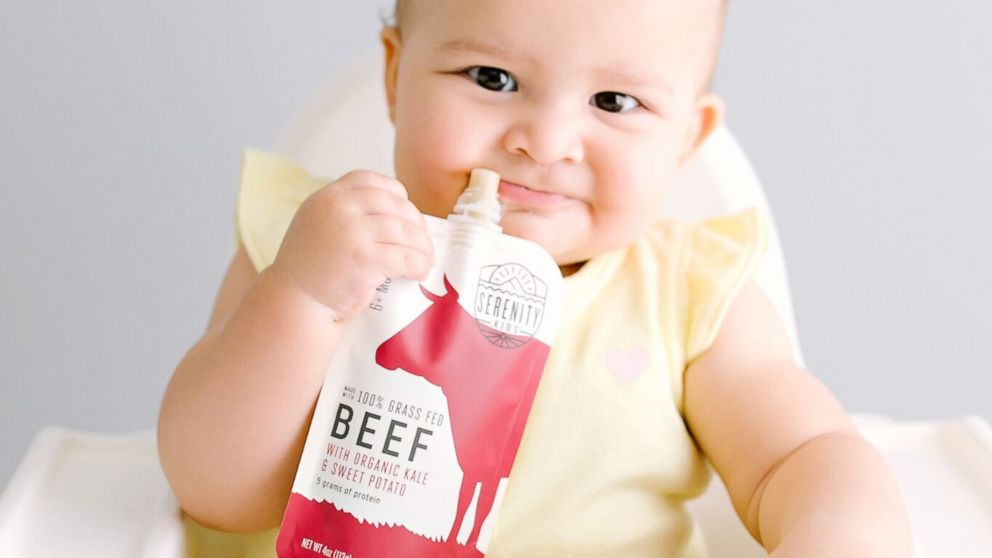 Also, they have a low acidity level, which makes them gentle on the tiny tummies. Puree steamed pear and add to the baby’s cereal.
Also, they have a low acidity level, which makes them gentle on the tiny tummies. Puree steamed pear and add to the baby’s cereal.
9. Milk:
At this stage, breast milk will provide total nutrition to your baby. Don’t even think of replacing breast milk or formula until 12 months of age. It can cause serious health implications. Also, never give your child low-fat or skim milk products until he is 2 years old. The 4 months old baby food is extremely delicious with milk.
10. Peas:
Image: Shutterstock
Fiber filled peas will make an ideal first veggie for babies. Steam the peas for 6 minutes and puree in a food processor, adding the cooking liquid. Strain using a sieve to discard the solids. Pea puree may thicken after it is refrigerated. So stir in a small amount of water, formula or breast milk while heating.
Tips
- A baby’s tummy is the size of his fist. Do not expect your baby to finish a meal. He probably will eat just ½ of a tablespoon portion of what you serve to him.

- Serve a food to baby for four days at a stretch. It will help you learn the signs of intolerance and allergy. Follow this process until your baby has tried a variety of foods.
- Always serve cooked veggies to your baby so that he can chew it easily. Cooking breaks down the cell wall, making the food easier to digest by the baby.
- Place the spoon near your baby’s lips and let him taste and smell. Don’t be surprised if your tot rejects the first spoon. Wait for a few minutes and try again.
- Do not add any salt or pepper to the baby food.
- As your baby gets used to solid food, make the puree less runny. You can mash the food instead of pureeing it.
1. What if a baby refuses their first solid food?
A baby might refuse solid food if they are full, unwell, or irritable. Hence, try feeding them when they are hungry. Check the consistency of the solid food and make it baby-compatible. Foods that are too hot or too cold might also be refused. Try a variety of foods initially to see the taste they prefer the most. If your baby still refuses to eat solid foods, consult a pediatrician.
Try a variety of foods initially to see the taste they prefer the most. If your baby still refuses to eat solid foods, consult a pediatrician.
2. Can I give my four-month-old orange juice?
Juices may seem easy to introduce babies to the taste of fruits. However, the American Academy of Pediatrics advises not to give babies juices until one year unless recommended by a pediatrician (1).
3. How do I keep baby foods safe?
Always feed your baby fresh, home-cooked food. Wash the ingredients properly in clean tap water. If you are preparing baby food in bulk, freeze the food immediately in a tightly sealed container. Label the container with the date of preparation and time. Only take out the required amount of food from the container when feeding a baby (2). Always check the quality of the food before feeding it to a baby.
If you are looking for food ideas for your 4-month-old baby, begin by offering easily digestible foods such as bananas, sweet potatoes, and cereals.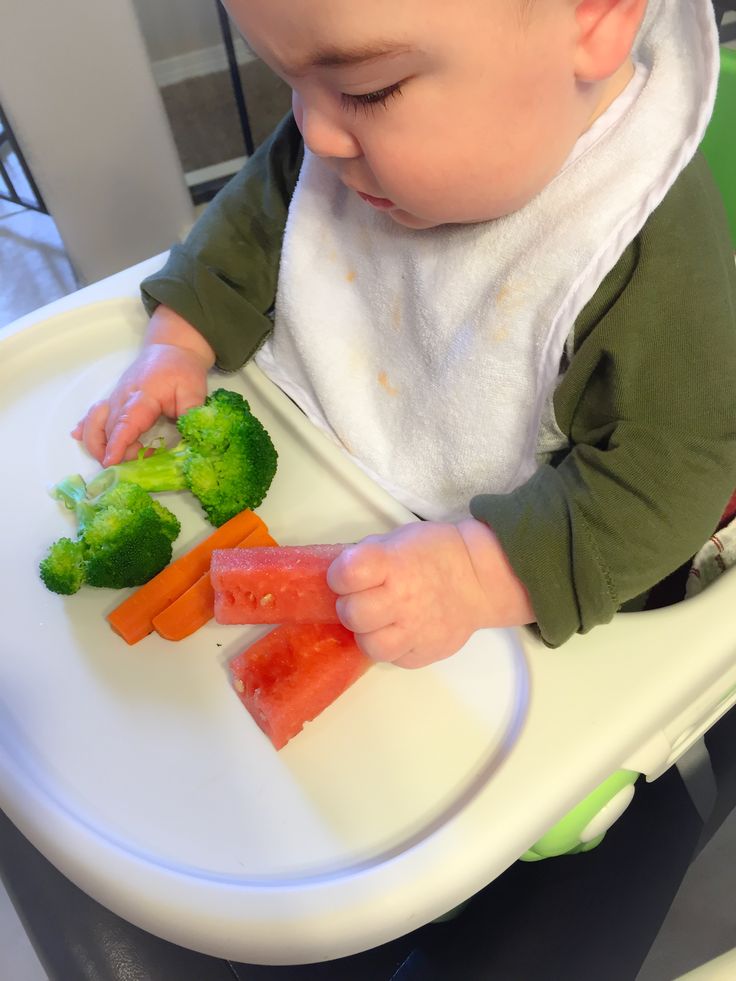 At four months, your tiny tot may be interested in eating foods other than milk. Though most babies are fed various solid foods after six months, you may introduce mashed forms of foods after they cross the four-month mark. Nevertheless, do not rush into introducing foods to your baby. Also, remember that all babies do not react to new foods alike. Hence, if you notice that your baby is not interested in certain foods, give them some time or try feeding other varieties.
At four months, your tiny tot may be interested in eating foods other than milk. Though most babies are fed various solid foods after six months, you may introduce mashed forms of foods after they cross the four-month mark. Nevertheless, do not rush into introducing foods to your baby. Also, remember that all babies do not react to new foods alike. Hence, if you notice that your baby is not interested in certain foods, give them some time or try feeding other varieties.
Key Pointers
- 4-month-old babies can consume the puree of avocado, banana, and carrots.
- To identify food intolerance issues while introducing solids, serve one food for three to four days instead of feeding mixed foods.
- Avoid adding spices or salt to baby food.
References:
MomJunction's articles are written after analyzing the research works of expert authors and institutions. Our references consist of resources established by authorities in their respective fields.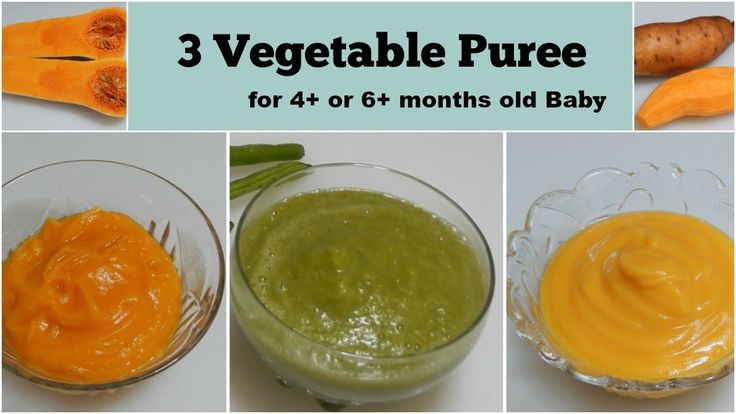 You can learn more about the authenticity of the information we present in our editorial policy.
You can learn more about the authenticity of the information we present in our editorial policy.
- Weighing in on fruit juice: AAP now says no juice before 1.
https://publications.aap.org/aapnews/news/14804 - How to make homemade baby food?
https://www.eatright.org/food/planning-and-prep/snack-and-meal-ideas/how-to-make-homemade-baby-food#
The following two tabs change content below.
- Reviewer
- Author
Jessica Albert is a passionate writer who seeks to connect with her readers through wit and charm. Her work aims to invoke curiosity and keep the readers engaged through and through. She has prior experience working with magazines and e-commerce establishments as a content marketer and editor. Being a mother herself, she puts all her knowledge into creating content about...
View Profile ›
Moloko Mehlape is a registered dietitian in private practice with special interest in nutrition education, sports nutrition, weight and chronic disease management. She is a philanthropist passionate about making a positive impact in public health through nutrition. Dt. Mehlape has completed extensive formal education and training, and holds qualifications BSc Dietetics (Hons) - Medunsa, MSc Dietetics from the University of...
She is a philanthropist passionate about making a positive impact in public health through nutrition. Dt. Mehlape has completed extensive formal education and training, and holds qualifications BSc Dietetics (Hons) - Medunsa, MSc Dietetics from the University of...
View Profile ›
Is It Safe To Use Baking Soda During Pregnancy?
Is It Safe To Use Baking Soda During Pregnancy?
Cheese During Pregnancy: What To Eat, What To Avoid
Cheese During Pregnancy: What To Eat, What To Avoid
Ginger For Babies: When To Start, Benefits And Precautions
Ginger For Babies: When To Start, Benefits And Precautions
Can You Eat Raspberries When Pregnant?
Can You Eat Raspberries When Pregnant?
Is It Safe To Eat Jelly During Pregnancy?
Is It Safe To Eat Jelly During Pregnancy?
4 Amazing Health Benefits Of Eating Biltong During Pregnancy
4 Amazing Health Benefits Of Eating Biltong During Pregnancy
9th Month Pregnancy Diet - Which Foods To Eat And Avoid?
9th Month Pregnancy Diet - Which Foods To Eat And Avoid?
Saffron During Pregnancy: Safety, Benefits And Side Effects
Saffron During Pregnancy: Safety, Benefits And Side Effects
Lemon For Babies: When To Introduce, Benefits And Side Effects
Lemon For Babies: When To Introduce, Benefits And Side Effects
How much should my baby eat? A guide to baby food portions
- Community
- Getting Pregnant
- Pregnancy
- Baby names
- Baby
- Toddler
- Child
- Health
- Family
- Courses
- Registry Builder
- Baby Products
Advertisement
Wondering how much to feed your baby? This can be hard to figure out, especially when you're starting solids and most of your baby's food ends up on your little one or the floor. It's also difficult to determine how much an 8-month-old (or older baby) should eat – babies this age are more interested in solid foods but still get most of their nutrition from breast milk or formula. This visual guide to baby food portions can help you figure out how much your baby should eat at every stage.
It's also difficult to determine how much an 8-month-old (or older baby) should eat – babies this age are more interested in solid foods but still get most of their nutrition from breast milk or formula. This visual guide to baby food portions can help you figure out how much your baby should eat at every stage.
Photo credit: Karla Martin for BabyCenter
How much should my baby eat?
Do you worry that your baby is eating too little or too much? Your baby will self-regulate her food intake based on what their body needs, so let their appetite be your guide.
It's helpful to have a reference point, however. Here are photos of how much solid food a baby typically eats in a day. You can also ask your baby's doctor for feeding advice.
This visual guide shows:
- Portions for infants who are new to solids (typically 4 to 6 months)
- Two sample meals for a younger baby (6 to 8 months)
- Three sample meals and two snacks for an older baby (8 to 12 months) from a menu developed by the American Academy of Pediatrics (AAP)
Your little one may eat less or more than what's shown here. Your job is to provide a variety of healthy foods at regular intervals without pressure, and their job is to decide what and how much to eat.
Your job is to provide a variety of healthy foods at regular intervals without pressure, and their job is to decide what and how much to eat.
Photo credit: iStock.com / UntitledImages
Watch for signs your baby is full
Lots of factors – including activity level, growth spurts or plateaus, illness, and teething – will affect your baby's appetite, which can vary daily.
End feeding when they signal that they're done. Signs of being full include:
- Turning their head away
- Refusing to open their mouth for another bite after they've swallowed (resist the urge to encourage your baby to have one last spoonful)
- Leaning back in their chair
- Playing with the spoon or food rather than eating
Photo credit: Karla Martin for BabyCenter
How much a 4- to 6-month-old should eat
When your baby is developmentally ready for solids, typically around 4 to 6 months, talk to their doctor about introducing solid foods. The first bites are mostly about them getting used to the idea of having something different in their mouth.
The first bites are mostly about them getting used to the idea of having something different in their mouth.
- Start with a very small amount, 1 to 2 teaspoons, of a single-ingredient puree.
- Gradually increase to 1 to 2 tablespoons of food once a day.
- Follow your baby's fullness cues.
Popular first foods include pureed mango, banana, chicken, turkey, beef, peas, sweet potatoes, and infant cereal. It's up to you what food to start with, but wait 3 to 5 days between introducing each new food to make sure your baby doesn't have an allergic reaction or food intolerance. (And remember, no cow's milk or honey until age 1.)
Photo credit: Karla Martin for BabyCenter
How much a 6- to 8-month-old should eat
As your little one gets more comfortable with solids, you can increase the frequency of meals and variety of food.
- Transition from one to two meals a day, typically by 8 months.
- Over time, add a second food to each meal.
 The photo above is an example of a meal with two foods.
The photo above is an example of a meal with two foods. - Once you've worked up to two meals with two foods each, aim for a balance of proteins, vegetables, fruits, and grains in their daily diet.
- Whenever you introduce a new food, start with a very small amount, a teaspoon or two, to allow your baby to get used to its flavor and texture.
- Start with a soupy consistency. Gradually add more texture as their eating skills improve.
Expect their intake of breast milk or formula to go down. They'll start drinking less of it as they eat more solid foods. Provide healthy options at mealtimes, and let them choose how much to eat.
Note: The jars in all photos are standard 4-ounce baby food jars.
Photo credit: Karla Martin for BabyCenter
Breakfast for a younger baby (6 to 8 months)
Cereal and fruit make an easy combination for a morning meal.
Grain: Iron-fortified, whole-grain infant cereal is a popular first grain.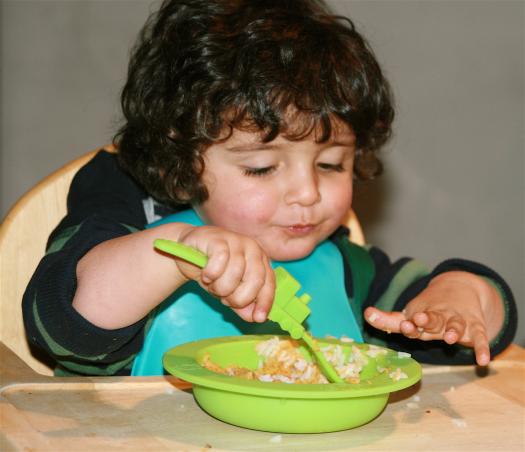 At 6 months, a typical daily portion of infant cereal mixed with breast milk or formula might be 2 to 3 tablespoons, increasing to 4 to 8 tablespoons (1/4 to 1/2 cup) by 8 months. (It's best to avoid rice cereal, though.)
At 6 months, a typical daily portion of infant cereal mixed with breast milk or formula might be 2 to 3 tablespoons, increasing to 4 to 8 tablespoons (1/4 to 1/2 cup) by 8 months. (It's best to avoid rice cereal, though.)
Fruit: Babies love the natural sweetness of fruits like pears, apples, berries, prunes, and stone fruits. Between 6 and 8 months, a baby will typically transition from about 2 to 3 tablespoons of fruit puree a day to 4 to 8 tablespoons (1/4 to 1/2 cup) of mashed or minced fruit.
Photo credit: Karla Martin for BabyCenter
Dinner for a younger baby (6 to 8 months)
If you serve a grain and fruit in the morning, consider offering a protein-rich food and vegetable later in the day. Your child may eat more or less than the amounts shown.
Protein: A baby might transition from eating 1 to 2 tablespoons of meat puree at 6 months to 2 to 4 tablespoons at 8 months, for example. Other good protein sources include cheese, unsweetened plain whole-milk yogurt, tofu, beans, and lentils.
Vegetables: Between 6 and 8 months, a baby will typically transition from about 2 to 3 tablespoons of vegetable puree a day to 4 to 8 tablespoons (1/4 to 1/2 cup). Try classic favorites like carrots, spinach, or butternut squash, as well as less traditional first foods such as parsnips, beets, or asparagus.
As your child's eating skills improve, gradually add more texture by dicing or mincing foods.
Photo credit: Karla Martin for BabyCenter
How much an 8- to 12-month-old should eat
By 8 months or so, your baby is likely getting the hang of eating and needs to eat more calories to support their growing body. But since their little belly can't hold a lot of food, they'll need to eat more often. Every baby is different, but this may be a good time to try offering a third solid food meal.
During this period:
- Continue to give your baby breast milk or formula.
- Add morning and afternoon snacks. (Some babies this age are happy with breast milk or formula as their snack, while others gravitate toward solid foods.
 ) Once you've added a third meal and snacks, your baby will be eating or drinking something about every two to three hours.
) Once you've added a third meal and snacks, your baby will be eating or drinking something about every two to three hours.
- Continue to aim for a mix of proteins, vegetables, fruits, and grains.
- Introduce coarser and chunkier textures, for example, by dicing or mincing food instead of pureeing it, and graduate to soft finger foods as your baby's eating skills improve.
- Avoid foods with added sugars. Check the Nutrition Facts label on packaged foods, and try to steer clear of foods that list 1 gram or more of "Added Sugars."
- Provide healthy options, and let your baby choose how much to eat.
To visualize daily portions for an 8- to 12-month-old, check out the following photos of a typical day's menu for a baby this age, developed by the AAP.
Your child may eat more or less than these amounts. If you're concerned about how much your baby is eating, talk to their doctor for advice.
Photo credit: Karla Martin for BabyCenter
Breakfast for an older baby (8 to 12 months)
The AAP sample menu for a baby 8 to 12 months features a breakfast consisting of:
- 4 to 8 tablespoons (1/4 to 1/2 cup) whole-grain infant cereal mixed with formula or breast milk
- 4 to 8 tablespoons (1/4 to 1/2 cup) diced fruit
Note: This is an example. Your baby may eat different foods and amounts.
Your baby may eat different foods and amounts.
Photo credit: Karla Martin for BabyCenter
Morning snack for an older baby (8 to 12 months)
The AAP sample menu for a baby 8 to 12 months features a morning snack consisting of:
- 4 tablespoons (1/4 cup) diced cheese or cooked vegetables
Note: This is an example of a morning snack, which babies typically add sometime between 8 and 12 months. Your baby may eat different foods and amounts.
Photo credit: Karla Martin for BabyCenter
Lunch for an older baby (8 to 12 months)
The AAP sample menu for a baby 8 to 12 months features a lunch consisting of:
- 4 to 8 tablespoons (1/4 to 1/2 cup) unsweetened plain whole-milk yogurt or cottage cheese, or minced meat
- 4 to 8 tablespoons (1/4 to 1/2 cup) diced or mashed yellow or orange vegetable
Note: This is an example. Your baby may eat different foods and amounts.
Photo credit: Karla Martin for BabyCenter
Afternoon snack for an older baby (8 to 12 months)
The AAP sample menu for a baby 8 to 12 months features an afternoon snack consisting of:
- 4 tablespoons (1/4 cup) diced fruit or unsweetened plain whole-milk yogurt
- 1 whole-grain teething biscuit or cracker
Note: This is an example of an afternoon snack, which babies typically add sometime between 8 and 12 months. Your baby may eat different foods and amounts.
Your baby may eat different foods and amounts.
Photo credit: Karla Martin for BabyCenter
Dinner for older baby (8 to 12 months)
The AAP sample menu for a baby 8 to 12 months features a dinner consisting of:
- 4 tablespoons (1/4 cup) minced or ground poultry or meat, or diced tofu
- 4 to 8 tablespoons (1/4 to 1/2) cup diced, cooked green vegetable
- 4 tablespoons (1/4 cup) noodles, pasta, rice, or potato
- 4 tablespoons (1/4 cup) diced fruit
Note: This is an example. Your baby may eat different foods and amounts.
Photo credit: Karla Martin for BabyCenter
How much should my baby drink once they start eating solids?
Breast milk or formula will fully meet your child's hydration needs until they're about 6 months old. They may start drinking less as solid foods become a bigger part of their diet. Here are typical daily amounts by age – your baby's intake may be different, however.
6 to 8 months: 24 to 32 ounces of formula, or continued breastfeeding on demand
8 to 12 months: 24 ounces of formula, or continued breastfeeding on demand
Water: You can offer your baby water once they start eating solids, but let them self-regulate how much they drink. The Centers for Disease Control and Prevention (CDC) recommends giving babies who are 6 to 12 months old 4 to 6 ounces of water a day, but what your baby decides to drink may vary. They may drink more on a hot day, for example.
Avoid juice: Juice isn't recommended for babies younger than 12 months.
Photo credit: iStock.com / SDI Productions
Your baby has the final say
Keep in mind that these portions are an estimate. The truth is, every baby is different, and there's no set amount of food that's appropriate for every baby at every stage.
If you're worried about whether your baby is eating enough – or too much – the best advice is to look for and respond to signs that your baby is full.
Your baby's doctor will chart their weight gain at regular intervals. If the doctor sees a consistent growth curve and doesn't have other concerns, your baby is most likely eating the right amount of food.
Hungry for more?
Age-by-age guide to feeding your baby
The 10 best foods for babies
The worst foods for babies
Using spices and seasoning in baby food
Elizabeth Dougherty
Elizabeth Dougherty is a veteran parenting writer and editor who's been contributing to BabyCenter since 2015. She's an intrepid traveler, devoted yogi, and longtime resident of Silicon Valley, where she lives with her husband and son.
Advertisement | page continues below
Development, nutrition and skills of a child at 4 months
Ekaterina Borisovna Bulavina
pediatrician of the 1st category
Your inquisitive four-month-old is drawn to socializing, playing and having fun - he has a huge potential for this. At this age, he is ready to move from cradle to crib, get a second immunization, and possibly try new foods. The development of a child at 4 months is multifaceted and everyone goes their own way. But there are a few common features that you should pay attention to so as not to worry about the health of your baby.
At this age, he is ready to move from cradle to crib, get a second immunization, and possibly try new foods. The development of a child at 4 months is multifaceted and everyone goes their own way. But there are a few common features that you should pay attention to so as not to worry about the health of your baby.
— Ekaterina Borisovna, babies in the fourth month of life see better and are already exploring the environment with their hands and mouth. Let's list what a child can do at 4 months.
Baby skills at 4 months:
- keeps head upright;
- shows more varied movements;
- learns to support with palms, rests on outstretched arms for some time;
- tries to crawl, makes worm-like movements towards the toy;
- actively puts his hands in his mouth, reaches for toys, can hold them, feels objects;
- rolls from back to side, can roll over to the stomach and back, but not necessarily;
- turns his head to the source of the sound, hums for a long time;
- expresses emotions, smiles, grimaces;
- is able to recognize mother, close people;
- , when called by name, quickly remembers and then recognizes his name.

— What height and weight can be considered normal for a four-month-old baby?
- By this age, the child usually adds up to 6-10 cm in height and doubles its weight from the moment of birth. The girths of the head and chest are usually compared, then the chest grows more intensively. The norms for a particular child can be assessed according to special centile tables used by pediatricians. Doctors also evaluate the harmony of physical development according to the correspondence of weight to height.
— How to recognize deviations in the development of a small child — what should parents pay attention to?
Physical indicators of the correct development of the child
- Deviations may occur if the rate of development slows down in a short period of time. For example, when a child grew, grew, grew and suddenly stops. The assessment of anthropometric indicators is carried out by the doctor on a monthly basis, and with a timely visit to the clinic, the pediatrician will definitely notice deviations in the development of the baby.
Motor activity of children
— In addition to assessing physical development, it is important to monitor the formation of motor skills. At four months, the baby is active and knows a lot. But if the child does not hold his head well, does not attempt to roll over, is not able to hold the toy, his emotions are scarce, he cries a lot, does not gurgle - these are alarming symptoms, and you need to see a doctor. The pediatrician will be able to determine the cause of the delay in psychomotor and physical development, prescribe additional examinations, adjust nutrition, and recommend a set of physical exercises.
See also
- food must not be given to children under four months of age
How to develop a child at 4 months
- Ekaterina Borisovna, is there a difference between the development of 4-month-old boys and girls?
- Boys are usually born larger than girls, and this trend continues in development for a long period of time. Often at this age, the height of boys reaches 66 cm, weight - 7.2 kg, while girls rarely reach 63 cm and their weight often does not exceed 6.5 kg. Otherwise, the differences between healthy children of both sexes at this stage are insignificant and depend on the constitutional features, character, nationality of the child and other factors.
Often at this age, the height of boys reaches 66 cm, weight - 7.2 kg, while girls rarely reach 63 cm and their weight often does not exceed 6.5 kg. Otherwise, the differences between healthy children of both sexes at this stage are insignificant and depend on the constitutional features, character, nationality of the child and other factors.
— What are the most common mistakes parents make when they are involved in child development?
— Mistakes are acceptable: not every mother immediately knows how to do the right thing. Let's talk about what not to do.
First type - errors in the mother-child relationship
The second type - pedagogical errors
- Feeding a child at 4 months - what to feed so that he grows up healthy?
— Regardless of the type of feeding, complementary foods should be introduced between the 17th and 26th weeks. It is optimal for a healthy baby to introduce complementary foods at five months. The minimum age at which complementary foods can be introduced is four months. By this period, the gastrointestinal tract gradually matures, the permeability of the mucous membrane of the small intestine decreases, a number of digestive enzymes are produced in sufficient volume, a good level of local immunity is formed, which reduces the likelihood of allergic reactions. The child is already able to swallow food thicker than milk or formula.
The minimum age at which complementary foods can be introduced is four months. By this period, the gastrointestinal tract gradually matures, the permeability of the mucous membrane of the small intestine decreases, a number of digestive enzymes are produced in sufficient volume, a good level of local immunity is formed, which reduces the likelihood of allergic reactions. The child is already able to swallow food thicker than milk or formula.
The timing of the introduction of complementary foods is set individually, taking into account the characteristics of the physical development, functioning of the digestive and nervous systems of the child.
At four months, children with low weight, with frequent stools, poor weight and growth gains can be offered gluten-free porridge, but for a child with overweight or a tendency to constipation - vegetable monocomponent puree. For the prevention of rickets and the proper absorption of calcium at this age, each child should receive vitamin D in a prophylactic dose.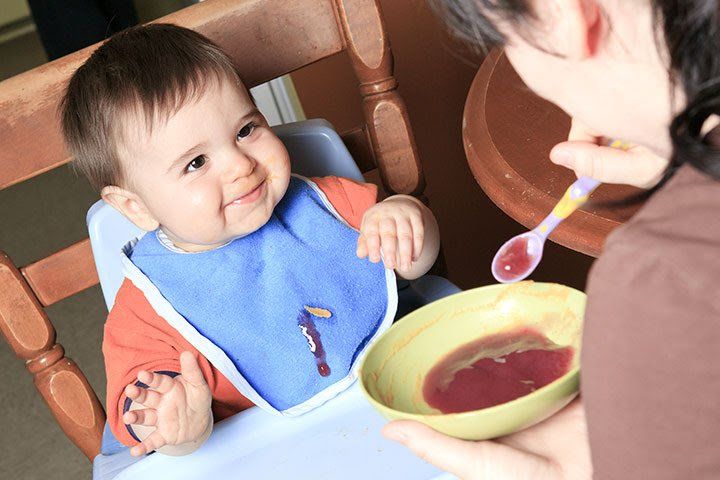 The therapeutic dose and indications for its administration are determined by the pediatrician.
The therapeutic dose and indications for its administration are determined by the pediatrician.
— How much can I feed my baby?
— It is recommended to start the introduction of complementary foods gradually with one teaspoon, bringing the volume up to the age norm within 5-7 days. On average, this is 50-70 g, but each portion will be individual. A new product should always be given in the morning so that it is possible to follow the reaction to its introduction. If there has been no reaction to a new food for several days, you can slightly shift the time of its intake. It is best to offer vegetable puree at lunchtime, and it is better to give cereals for dinner so that the child stays full longer and gradually weaned from night feedings.
— What can be given to a child at 4 months if the mother does not have enough breast milk or if lactation needs to be completed?
- At such times, the baby can be transferred to mixed or full artificial feeding. For a healthy baby with no allergy symptoms, a pediatrician may offer an adapted goat milk formula. It has several advantages over formula based on cow's milk: it is easier to digest, less allergenic, causes less digestive problems and is suitable for most healthy babies, as well as some babies with cow's milk protein intolerance.
For a healthy baby with no allergy symptoms, a pediatrician may offer an adapted goat milk formula. It has several advantages over formula based on cow's milk: it is easier to digest, less allergenic, causes less digestive problems and is suitable for most healthy babies, as well as some babies with cow's milk protein intolerance.
4-month-old forbidden menu:
- adult foods not intended for infants during their first year of life;
- products of inhomogeneous consistency;
- products containing flavorings, preservatives, spices, salt, sugar;
- whole cow's or goat's milk, juices;
- products intended for babies in the second half of life - gluten multicomponent cereals, meat puree, fish, dairy products. Terms of their introduction - 6-8 months;
- expired and expired products.
— Are the abilities of four-month-olds breastfed and bottle-fed different?
- With a properly selected mixture, there are no significant differences in the development of infants who are on different types of feeding. Modern adapted mixtures are as close as possible to mother's milk in their composition and contain the entire set of nutrients necessary for the full development of the baby. Before switching to mixed or artificial feeding, the doctor will recommend an adapted formula, depending on the individual characteristics of the child.
Modern adapted mixtures are as close as possible to mother's milk in their composition and contain the entire set of nutrients necessary for the full development of the baby. Before switching to mixed or artificial feeding, the doctor will recommend an adapted formula, depending on the individual characteristics of the child.
For a healthy baby with no signs of allergy, digestive complaints or cases of family intolerance to cow's milk proteins, the doctor may recommend a goat's milk formula. It will be preferable to cow's milk formula.
As a first mixture, I recommend MAMAKO ® Premium Goat Milk. Milk in the stomach forms a soft curd clot, it is well broken down by enzymes and absorbed. It also contains virtually no complex alpha-S1-casein protein, so the mixture is less allergenic and easier to digest. In addition, it contains:
- Omega-6 and Omega-3 amino acids in the maximum ratio and lutein - such an IQ complex is necessary for the proper development of vision and the brain;
- pre- and probiotic complex - the gastrointestinal tract is populated with beneficial microorganisms that inhibit the growth of opportunistic microflora, normalize digestion and have a positive effect on the immune system.

These unique properties allow MAMAKO ® Premium to be recommended as a good alternative to mother's milk when complementary or artificial feeding is required.
At four months, the baby continues to grow actively, but the gains are no longer as noticeable as in the first three months of life. At this age, it is useful to do gymnastics and do a light massage, offer the child a variety of toys and introduce him to the wonderful world of sounds, spend enough time outside. If necessary, the baby can try the first meal of complementary foods - vegetable puree or porridge. But do not rush the natural development of the baby, load it with too intense physical activities, offer products that are not age-appropriate. Be sure to visit a pediatrician in a timely manner and follow his recommendations.
* Breast milk is the best food for babies. WHO recommends exclusive breastfeeding for the first 6 months of a child's life and continued breastfeeding after complementary foods are introduced until the age of 2 years. Before introducing new products into the baby's diet, you should consult with a specialist. The material is for informational purposes and cannot replace the advice of a healthcare professional. For feeding children from birth.
Before introducing new products into the baby's diet, you should consult with a specialist. The material is for informational purposes and cannot replace the advice of a healthcare professional. For feeding children from birth.
#Baby development
See also
Myths and truths about canned baby food
#Complementary food
Bulavina Ekaterina Borisovna
pediatrician of the 1st category
Complementary food menu: what to give in the morning, afternoon and evening
#Food #oatmeal
Kizino Polina Alexandrovna
pediatrician, perinatal psychologist
When to start complementary foods. First food
#Food #first food #organic cereal buckwheat #organic porridge rice #set first lure #buckwheat #corn #rice
Shcherbakova Alla Anatolyevna
Candidate of Medical Sciences, pediatrician, gastroenterologist
See all
View all
View all
Myths and truths about canned baby food
# Lure
Bulavina Ekaterina Borisovna
pediatrician of the 1st category
Complementary food menu: what is better to give in the morning, afternoon and evening
# Lure #prikorm # oatmeal
Kizino Polina Alexandrovna
pediatrician, perinatal psychologist
When to start complementary foods. First food
First food
# Lure #prikorm # first food # organic porridge buckwheat # organic porridge rice # first food set # buckwheat # corn # rice
Shcherbakova Alla Anatolyevna
Candidate of Medical Sciences, pediatrician, gastroenterologist
See all
View all
View all
Senator Rossel suggested that foreign baby food changes the genes of children in Russia - Gazeta.Ru
Senator Rossel suggested that foreign baby food changes the genes of children in Russia - Gazeta.Ru | NewsThe President of Romania called for the implementation of the decision to strengthen NATO in Eastern... 19:44
The bus of the Swiss national team had an accident before the match with the Brazilians... 19:44
The petition to ban the Russian Orthodox Church in Ukraine has received what Zelensky needs to consider... 19:40
Quarantine introduced in Elista due to the threat of the spread of influenza and SARS 19:39
Russian restaurants entered the La Liste international rating for 2023 19:37
"Nose fracture, concussion": after a fight in a gym class. .. 19:30
.. 19:30
Russian Ambassador Stepanov summoned to the Canadian Foreign Office 19:29
Ronaldo's girl came to the casino in a dress with "bills for thousands of... 19:28
Spartak football players watched the video of the fight in the locker room... 19:27
Margot Robbie and Brad Pitt star in 1920s Hollywood in trailer... 19:27
Society
close
100%
Former head of the Sverdlovsk region, member of the Federation Council Eduard Rossel at the Demidov readings spoke about the dangers of foreign baby food. In his opinion, modern technologies make it possible to regulate genes through baby milk.
“This is a terrible thing, because science has already come to such an “achievement” that through baby milk, by regulating genes, it is possible to make it so that only girls will be born. I see ten children are born. Two guys, the rest are girls. I think we got it already? This is national security!” - the Komsomolskaya Pravda website quotes the senator.
Two guys, the rest are girls. I think we got it already? This is national security!” - the Komsomolskaya Pravda website quotes the senator.
In an interview with Gazeta.Ru, Rossel explained that he had been studying this issue together with businessman and chairman of the Public Chamber of the Sverdlovsk Region, Sergei Maizel.
“I dealt with this problem with Sergei Meisel. We have prepared a program for the development of domestic baby food. We can’t get through the Ministry of Industry and Trade,” the senator explained.
In turn, Meisel confirmed Rossel's words about the possibility of gene editing with the help of baby food.
“Today, it has become possible to edit the gene chain so that there will be a predominance of one or another gender population. Therefore, in ideology, he (Eduard Rossel - ed.) is certainly right, ”he told Gazeta.Ru.
At the same time, the interlocutor claims that the existence of such a technology has been known for a long time.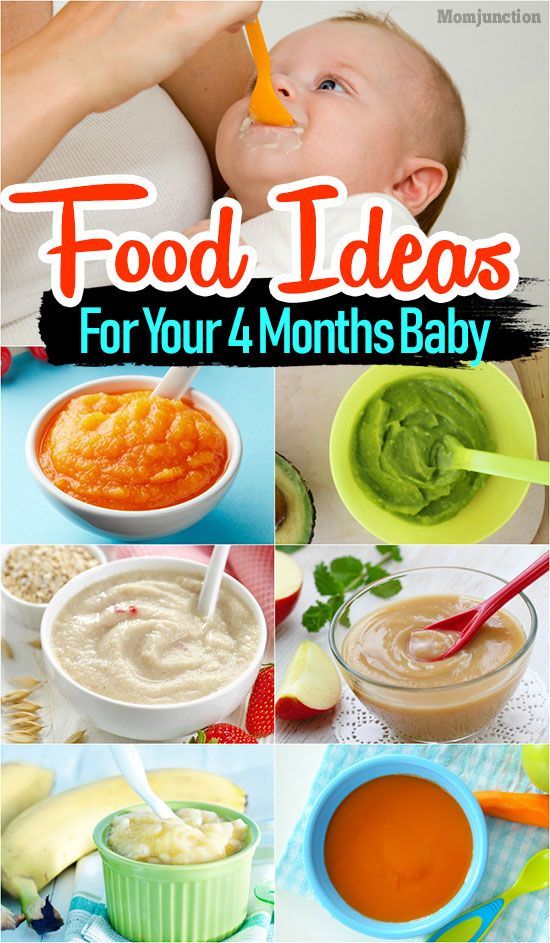 “This story is already 20 years old. This is not any kind of revelation. It is very easy to prove, it is enough to check the change in the gene chain, ”he concluded.
“This story is already 20 years old. This is not any kind of revelation. It is very easy to prove, it is enough to check the change in the gene chain, ”he concluded.
RELATED NEWS:
— In the Moscow region, a father poisoned his four-month-old son to death with sleeping pills
— A father poisoned a noisy baby with sleeping pills in Pushkino
Subscribe to Gazeta.Ru in News, Zen and Telegram.
To report a bug, highlight the text and press Ctrl+Enter
News
Zen
Telegram
Picture of the day
Russian military operation in Ukraine. Day 278
Online broadcast of the military special operation in Ukraine — Day 278
Used drugs and got behind the wheel. New details of a deadly accident in Moscow
Moscow Prosecutor's Office: the woman who killed her mother and child was under the influence of drugs
"Sanctions against the bloody regime are ridiculous. " Why was the niece of the Iranian Ayatollah arrested
" Why was the niece of the Iranian Ayatollah arrested
The niece of the Iranian Ayatollah Khamenei was arrested for anti-government calls
Strana.ua reported explosions in Kherson
Quarantine was introduced in Elista due to the threat of the spread of influenza and SARS
Kaczynski said that Germany will not shoot down Russian missiles flying to Poland
A serviceman from Tuva is suspected of killing a resident of the Novosibirsk region
News and materials
The President of Romania called for the implementation of the decision to strengthen NATO in Eastern Europe as soon as possible
The bus of the Swiss national team had an accident before the match with the Brazilians at the World Cup
The petition to ban the Russian Orthodox Church in Ukraine gained the number of signatures necessary for Zelensky to consider
Russian restaurants are included in the La Liste international rating for 2023
“Nose fracture, brain concussion”: after a fight in a physical education class, a child was taken to the hospital
Russian Ambassador Stepanov was summoned to the Canadian Foreign Office
Ronaldo's girlfriend came to the casino in a dress with "thousand dollar bills"
Spartak players watched a video of a fight with Zenit players in the locker room
Margot Robbie and Brad Pitt star in 1920s Hollywood in Babylon trailer
In the USA, a man stole a bus and damaged ten cars
Blogger Maddison, who left Serbia, was suspected of returning to Moscow
In St.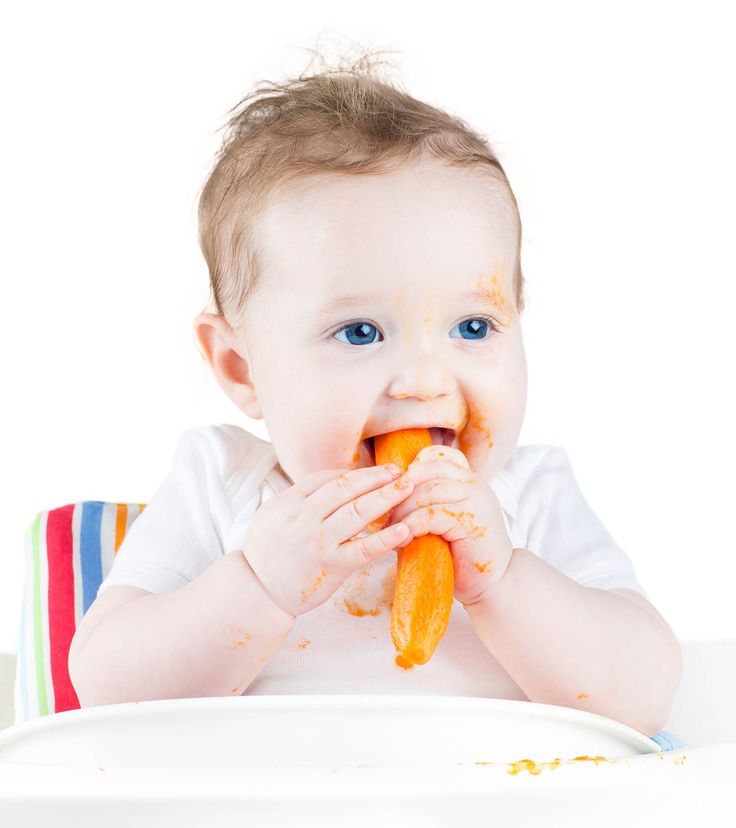 Petersburg, a migrant was arrested, accused of killing a Russian woman dissatisfied with the repair
Petersburg, a migrant was arrested, accused of killing a Russian woman dissatisfied with the repair
Kuleba: Foreign Ministers of NATO countries will hold talks in Bucharest on the supply of weapons to Ukraine
The British Foreign Office commented on the protests in China
Electric scooter rental service Whoosh announced its intention to conduct an IPO
Moscow traffic police named the most common traffic violations in 2022
State Department: US prioritizes resuming inspections under START
Sollers named prices for new models released under its own brand
All news
No nuclear war and falsification of history.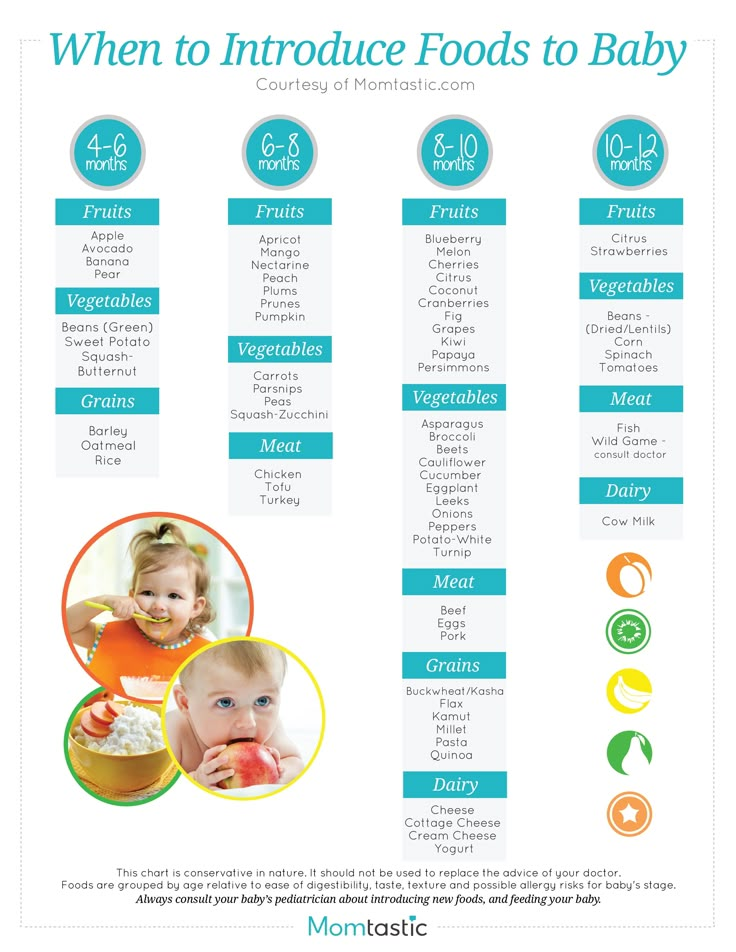 Putin and Tokayev signed a declaration
Putin and Tokayev signed a declaration
Putin and Tokayev signed a declaration on the occasion of the 30th anniversary of diplomatic relations
“Lebanon is no longer an independent state”
How the USA and Syria deprived Beirut of its independence
Director Ivan Sosnin talks about Distant Lovers, the last role of Yevgeny Syty and the power of good cinema
The director of "Far Close" Ivan Sosnin spoke about the last role of Yevgeny Syty
The Council of the EU recognized the circumvention of anti-Russian sanctions as a crime
The Council of the EU unanimously declared the circumvention of sanctions a crime against the European Union
Peskov denied rumors about the withdrawal of troops from Energodar and from the Zaporozhye NPP
Peskov said that he did not see the call of the mothers of the mobilized to withdraw troops from Ukraine
Spring deliveries.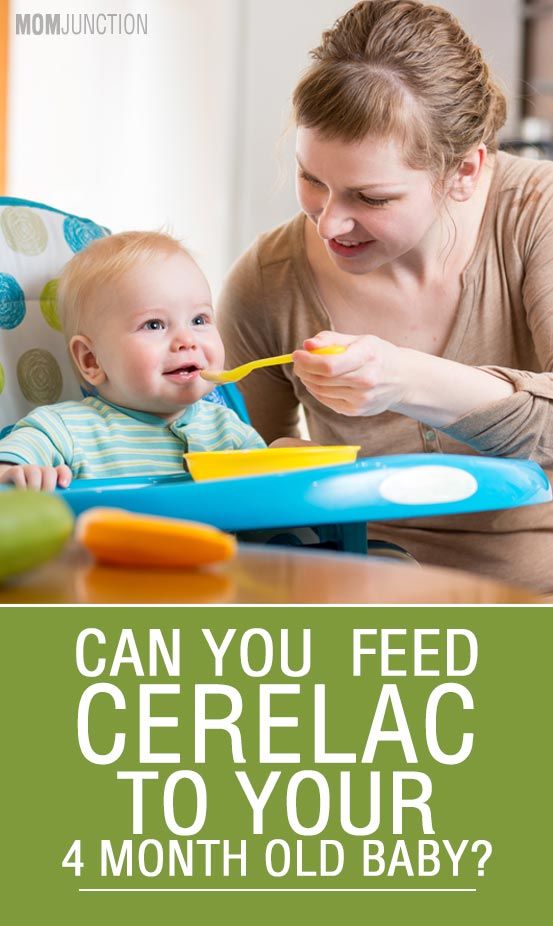 Boeing wants to give Kyiv bombs that can hit Russia
Boeing wants to give Kyiv bombs that can hit Russia
Reuters: Boeing offered to supply Kyiv with ammunition to hit Russia
Back to the past: the stars "meet" themselves young
Mercury, bismuth and arsenic were found in Saakashvili's analyzes. Experts talk about poisoning0003
“What missiles? What tanks? What is World War III? What are we doing here?"
Ukrainian Foreign Minister Kuleba: Kyiv's partners are working with third countries to buy weapons
Forex Club founder Vyacheslav Taran died in a plane crash in Monaco
He flew home from Switzerland
“The battles for Artemivsk became a “bloody whirlwind”: NYT reported heavy losses of the Armed Forces of Ukraine
NYT reported that more than 240 Ukrainian servicemen were wounded during the battles for Artemivsk
Nuclear risks without Ukraine: what the heads of intelligence of the Russian Federation and the United States discussed in Ankara
US Charge d'Affaires in Moscow: Burns and Naryshkin did not discuss the issue of peace in Ukraine in Ankara
"Will be in the dark.





